Dreaming of Travel: Death Valley National Park
Published on February 16, 2021 - Updated on February 16, 2021
There are so many things about Death Valley that make it memorable, but the most surprising may be that it is family-friendly!
Death Valley. The name alone is enough to conjure visions of bleached animal skulls, circling vultures, and glimmering mirages on lonely highways. While it’s true that the area is one of the harshest places on Earth with temperatures that soar over 110° F in the summer and precious little water available to sustain life, Death Valley National Park is not some insurmountable barren landscape that should be avoided. Quite the contrary. Brave-hearted adventurers and explorers (and families with children of all ages!) will find an experience filled with spectacular history, beauty, and wonder.
The vastness and diversity of life and land in the 3 million acres of wilderness area is nothing short of awe-inspiring. From salt flats and sand dunes to giant craters and colorful canyons, Death Valley offers a week or more of adventures for those that are lucky enough to visit.
Things to Know
It goes without saying that Death Valley gets hot. Very, very hot. In the summer, temperatures can reach well over 100 degrees. The best time to visit the park is late fall-early spring; November through March are ideal with temperatures ranging from the upper-60s to low 80s. If you can’t make it during those months you should plan to do most of your activities early in the morning or in the evening when the temperatures are cooler.
Cell service is spotty in the park. Service is generally good in developed areas of the park, such as Furnace Creek, but may be unavailable in other areas. It’s a good idea to download an offline map to your cell phone before you leave home. Keeping a park map handy to navigate the park roads is also a good idea.
Amenities in Death Valley are sparse. While the park has some camp stores that offer necessities, you will pay a premium. Gas stations are also available within the park but again, prices can be steep. Be sure to do your shopping before you leave home as you will likely have to travel at least an hour from the park to get to a grocery store. If you’re looking to get a night off from cooking, there are some café and restaurants available within the park at The Inn at Death Valley, The Ranch at Death Valley, and Panamint Springs Resort. Other restaurants are available in surrounding towns that are around 30-60 minutes from the Furnace Creek Visitor Center.
We spent 4 full days exploring the park and felt that we easily could have spent more. If all you have is a day, you can still see the highlights and absorb some of the magic of Death Valley. If you’re lucky enough to have more time, you could easily fill a week (especially if you’ve got kids in tow and need to move at a slightly slower pace). We recommend giving yourself as much time as possible if you want to truly experience everything the park has to offer.
Where to Stay
If you book your trip early enough, you may be able to nab a spot to stay within the park. Death Valley even has three historic hotels within the park boundaries, The Inn at Death Valley, The Ranch at Death Valley and Panamint Springs Resort.
If camping is more your speed, the park also offers a variety of camping options including RV spots with hook-ups in the Furnace Creek and Stovepipe Wells areas. Both campgrounds as well as several others also offer no hook-up sites for RVs as well as tents. If you’re really feeling adventurous, free backpacking sites are available at some of the higher elevations of the park. When choosing a campground, be sure to check out a map to determine its location. Furnace Creek and Stovepipe Wells Campgrounds are the most centrally located while others may be a bit farther from the action.
If you’d rather stay outside of the park or aren’t able to make a reservation within the park, there are several nearby towns that offer both hotel and camping options. Death Valley Junction, CA, Beatty, NV, and Amargosa Valley, NV are all within an hour of the Furnace Creek Visitor Center. All three are small towns that offer hotel lodging and camping as well as some basic amenities such as restaurants and general stores. Pahrump, NV is a bit farther but offers every amenity you might need including grocery stores, coffee shops, and more.
One important note: the elevation difference between the surrounding towns (or even certain campgrounds within Death Valley) can make for vastly different weather between where you might be staying and what you’ll experience in the park. During our stay, we were in Beatty, NV at an elevation of around 3,000 feet. This meant that the temperatures in Death Valley were around 15-20° warmer than it was at our campground at any given time. Be sure to pack for and dress for these temperature variations!
Itineraries
While Death Valley does require a bit of driving to get around, the park is arranged in such a way that you can minimize your travel time with a little bit of strategic planning. Each road within the park offers many spectacular features that will keep both kids and grown-ups happy. We recommend starting each day by driving to the destination that is farthest from the center of the park and working your way in! (This method also allows easier access to destinations that you may miss out on if the kids tucker out early in the day.) The itineraries below are arranged in a farthest to nearest format to minimize your drive time and maximize your fun!
Day 1:
Furnace Creek Visitor Center
Start your day with a visit to the centrally located Furnace Creek Visitor Center. There you can pay your park entry fees, grab a junior ranger book and also a map. You’ll also find restrooms, water, picnic tables, and a gift store for souvenirs. The visitor center also provides information on the park’s natural and historic features.
If you are a Star Wars fan, you will likely already know that several scenes in Ep. 4 and Ep. 6 were shot in the park. Be sure to ask for more information at the visitor center. They will be able to give you the details on which scenes were shot where!
Badwater Basin
Badwater Basin is probably Death Valley’s most notable feature. At 282 feet below sea level, this area of the park is the lowest point in North America. While you can see the salt flats from your car, you won’t get a good view of the spectacular geometric salt formations without doing a little walking. The walk is flat and relatively short- a 1/2 -3/4 mile walk will get you out far enough to see the stunning patterns.
Natural Bridge
The Natural Bridge trail is a short hike to see a spectacular natural bridge that spans a large canyon. The hike to see the bridge is short (around 1/3 mile) but families with kids who like to rock scramble may want to head a bit farther in. You can climb up and over small rock ledges until you reach a 15-foot (unscalable) canyon wall about 1-mile in.
Devil’s Golf Course
Devil’s Golf Course is an easy stop that shouldn’t be missed. Yet another wondrous geologic formation that you’re unlikely to see anywhere else, this area is a landscape that is heavily influenced by the impact of rain, evaporation, and salt. Families can see the landscape from a car in the parking lot but older kids will likely want to get out and explore the jagged ground protrusions that are the area’s namesake. (If you do get out to explore, be sure to hold the hand of any little ones that aren’t stable on their feet as the salt that covers the formations can be quite sharp!)
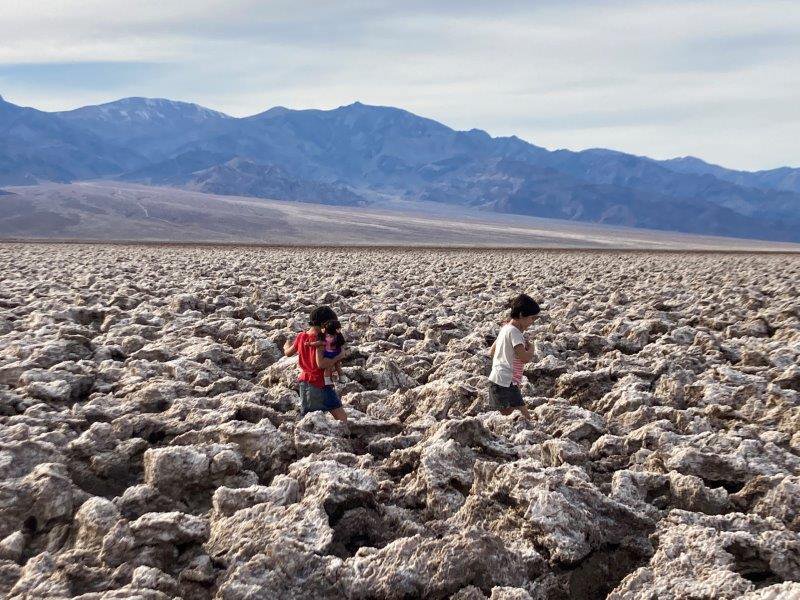
Artist’s Drive
After a long day of exploring, Artist’s Drive is an easy way to end the day. The road is a scenic 9-mile drive that will take you through the colorful hills of the area. If you want to take a closer look at the multi-hued rocks, park at the Artist’s Palette and take a short walk to see the rainbow-colored rocks up close!
Day 2:
Dante’s View
Dante’s View is a bit of a drive, but well worth it. This scenic viewpoint will allow you to view Death Valley from 5,000 feet above. To say that the view is breath-taking is an understatement. There’s no hiking required to enjoy this destination; you can reach the overlook simply by crossing the parking lot. Due to the elevation, Dante’s View is much colder than the lower points in Death Valley. Be sure to pack an extra sweater or jacket if you’re visiting in the winter!
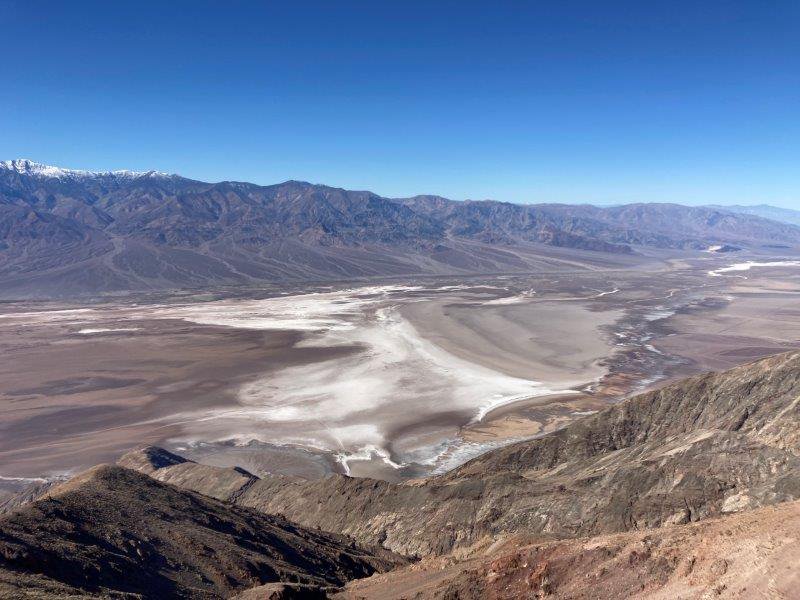
Zabriskie Point
A ¼-mile walk up a paved (but steep) path will take you to a viewpoint above the golden-colored badlands of Zabriskie Point. Viewing the landscape from above is awe-inspiring but those that wish to get a little closer can enjoy exploring the area via trails at ground level. Little ones with extra energy will surely enjoy “getting lost” in the maze of badland hills.
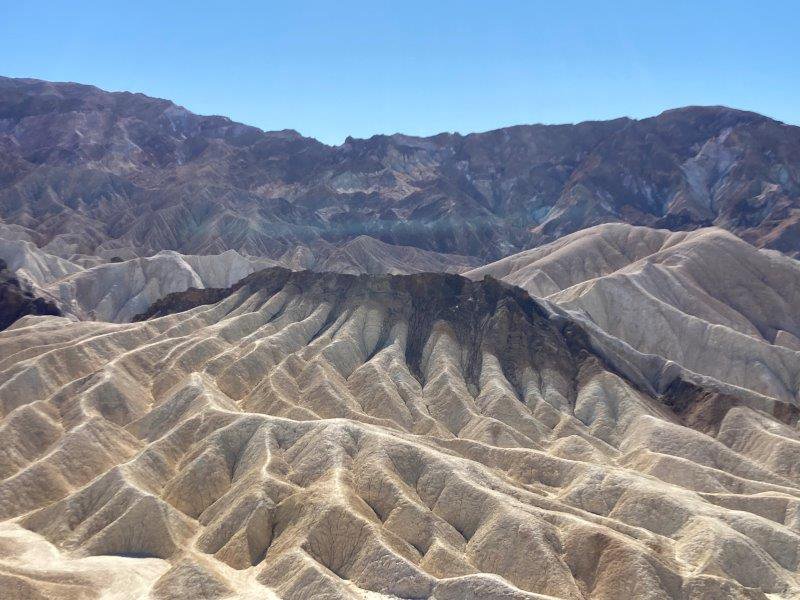
Golden Canyon
For those that love rock scrambling, Golden Canyon is a great destination. The hike starts off easy with a flat walk into the canyon, and then quickly gets more interesting. After hiking around ¼ mile, you’ll come upon a series of slot canyons (small canyons that have been carved into the larger canyon walls). From there, you can follow the maze up and through the spectacular rock formations.
Day 3:
Ubehebe Crater
Ubehebe Crater is another long drive but offers a unique opportunity to see a massive crater that was formed 2,000 years ago after superheated steam and gas exploded, resulting in a 600-foot deep hole in the Earth. You can view Ubehebe Crater from a viewpoint that is adjacent to the parking lot. If you want to do some more exploring, you can take a short walk up the hill from the parking lot to view and walk down into a smaller crater called Little Hebe.
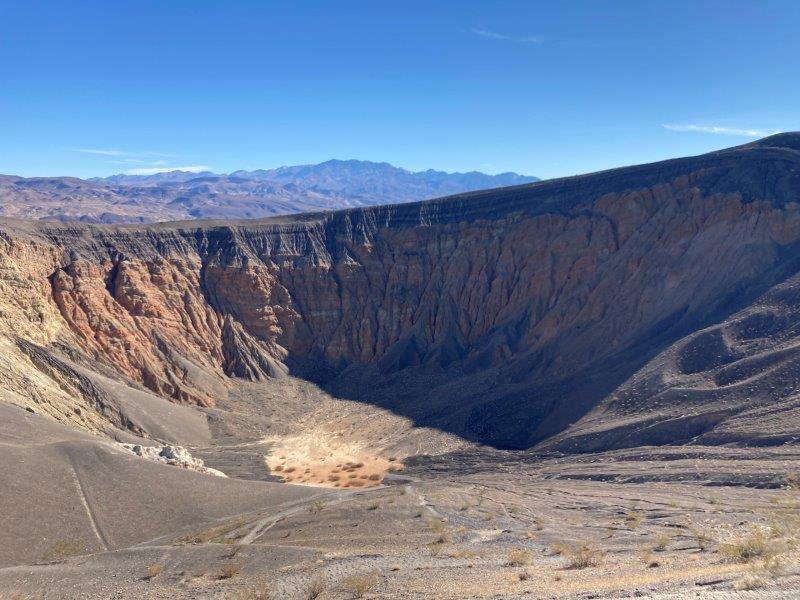
Mesquite Flat Sand Dunes
Mesquite Flat is one of the more popular stops in the park. Rolling hills of incredibly soft sand line the valley for miles. Take your time here and look closely, you’ll likely see the tracks of the many animal inhabitants of the area including ravens, roadrunners, lizards, kangaroo rats and more. The sand dunes are adjacent to the parking lot and there are no marked trails so you can make your hike as long or as short as you’d like!
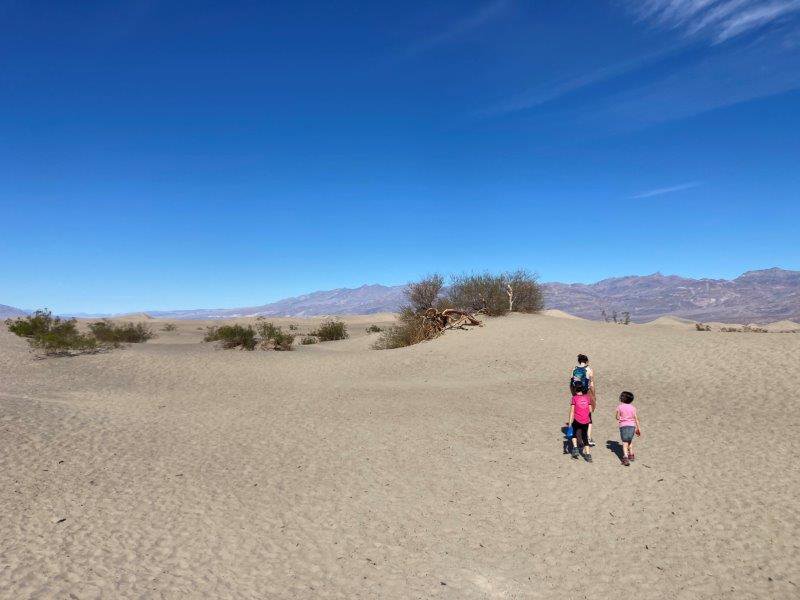
Salt Creek
Salt Creek Interpretive Trail is a spot that we stumbled upon by accident and we were so glad we did. As the name indicates, the main feature in the area is an incredibly salty creek. What makes the creek so special (besides the fact that it’s a creek flowing through one of the driest places in North America!) is that it’s the home of the Salt Creek Pupfish. This fish lives nowhere else in the world and has adapted to live in the harsh environment that Salt Creek provides. The ½- mile boardwalk trail will take you along Salt Creek, where you can spot the fish. Be sure to read the informational sign at the beginning of the boardwalk. There you’ll be able to get find out the best place to spot the fish, depending on the time of year you are visiting.
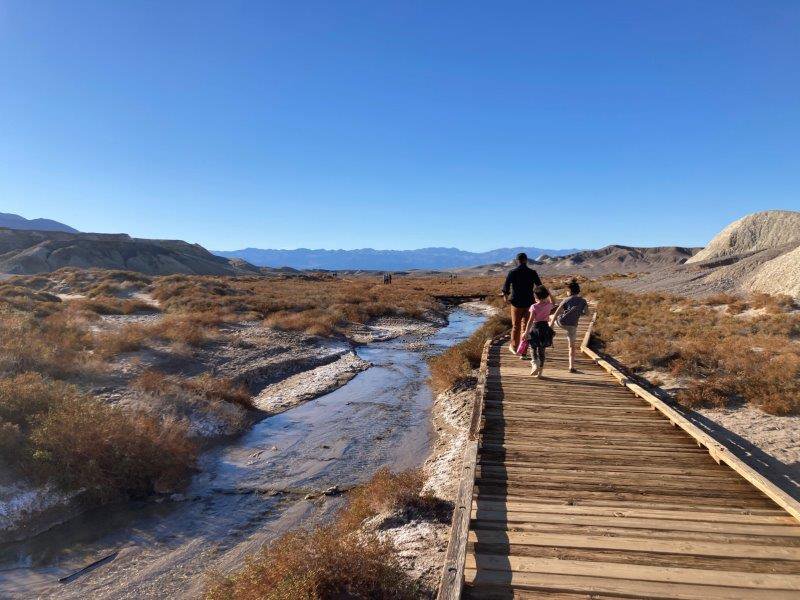
Keane Wonder Mill and Mine
Death Valley is full of so many geologic wonders, it’s easy to forget that this area was used for many industries before its protection by the National Park Service. Keane Wonder Mill and Mine is just one of those many industries. A short, steep walk from the parking lot will take you to the lowest tram terminal of the remaining wooden aerial trams that were used at this historic gold mine. After days of exploring the natural features of the land, this stop makes for a fun change of pace.
Other Things to Do
Stargazing
Death Valley is renowned for its stargazing. With amazingly dark skies and wide-open landscape, you’re unlikely to find a much better spot to take in the views of the night sky. Mesquite Flat Sand Dunes, as well as Harmony Borax Works, are both great locations to take in the stars. Be sure to ask at the Ranger Station about special Night Sky Explorer Junior Ranger books for any elementary-aged kids in your group!
Biking
Death Valley does offer one paved, dedicated biking trail that runs 1-mile from Furnace Creek Visitor Center to Harmony Borax Works. Other than that, the biking options are limited to gravel or dirt roads that are shared with cars. If you’ve got older kids, these may be viable options, but for families with very young children, safe and enjoyable biking trails may be relatively limited.
Rhyolite Ghost Town
A little outside of the official boundaries of Death Valley National Park lies Rhyolite Ghost Town. This town is managed by the National Park Service and is a fun stop if you’ve got extra time. Rhyolite boomed as a mining town for almost a decade before being completely abandoned. After several days of intense hiking in Death Valley, our kids loved wandering around these forgotten buildings and imagining the people that lived there so many years ago.
Taking a Death Valley Vacation with Kids
Death Valley may seem like a daunting trip for families, but after our experiences there with children in tow, we can assure you that it is well worth it. After visiting many national parks, our kids agreed that Death Valley was easily one of their favorites. With so many short hikes and easy-to-reach vistas, Death Valley is an ideal National Park vacation for any family with little kids!
What’s your favorite road trip destination? Share your highlights on Instagram @gethappyly.
Explore more of our Dreaming of Travel series in a music lover’s paradise like Memphis, or find your happy place on Bear Lake: An Adventurer’s Oasis. If you’d prefer , Make Nature Your Focus in Harper’s Ferry, Plan Your Next Adventure in Savannah, Explore Grand Teton or Yellowstone, Dream about a Tubing Adventure in Salida, Colorado, or check out the recent blogs by Colin Boyd to further fuel your wanderlust in the Dry Tortugas or at Mojave National Preserve.
If you have a perfect getaway or a favorite landscape, please reach out to us at team@happyly.com and we'll be excited to cover it! If you love exploring near and far as much as we do, please download the happyly app today!